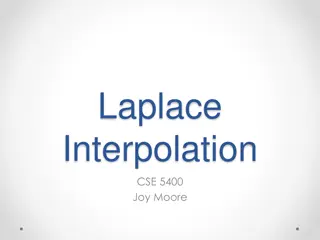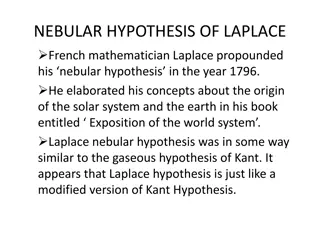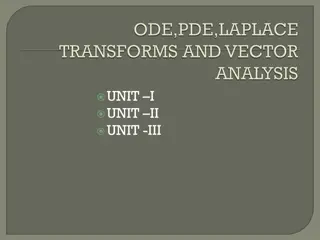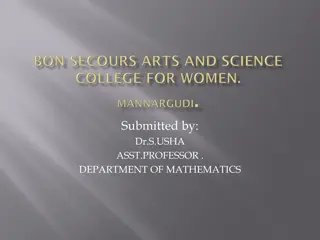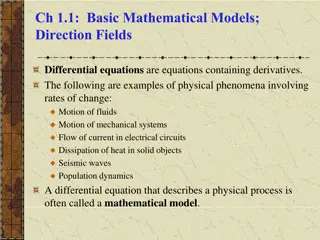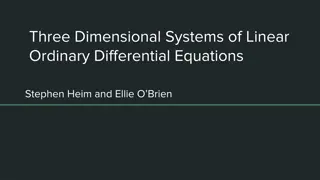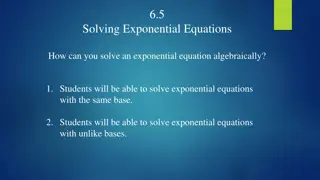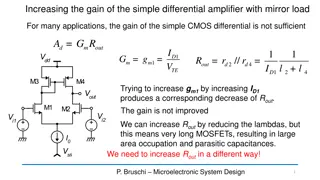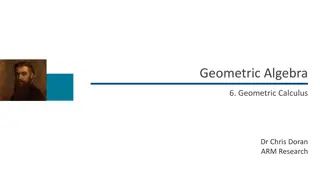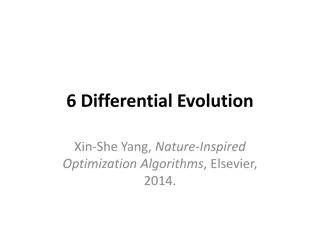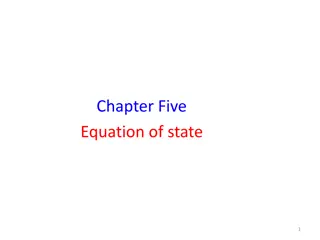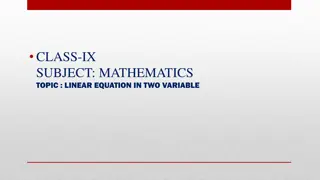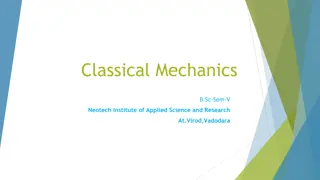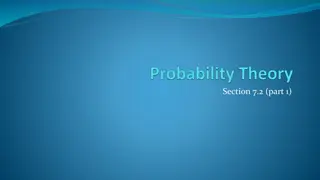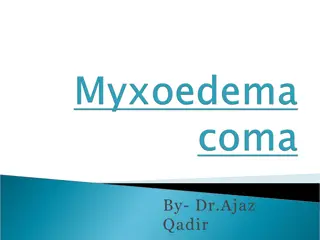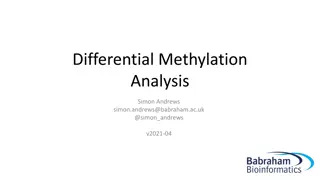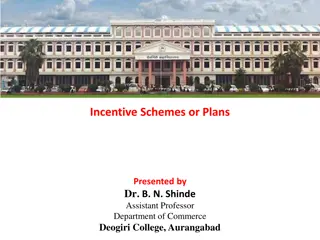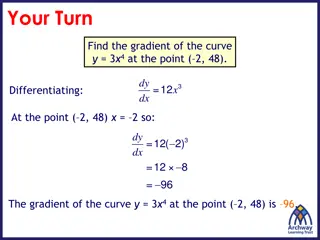Introduction to Differential Equations and Laplace Equations
Understanding differential equations of various orders, solving methods, linear and non-linear equations, ordinary and partial differential equations, definitions of solutions, and general vs. particular solutions in the context of Differential Equations and Laplace Equations.
Download Presentation

Please find below an Image/Link to download the presentation.
The content on the website is provided AS IS for your information and personal use only. It may not be sold, licensed, or shared on other websites without obtaining consent from the author. Download presentation by click this link. If you encounter any issues during the download, it is possible that the publisher has removed the file from their server.
E N D
Presentation Transcript
Dfferential equations and laplace equations UNIT I UNIT II UNIT -III
Introduction to Differential Equations Differential Equations of First Order and First Degree: Definition and method of solving of homogeneous differential equations, Definition and method of solving of Linear differential equations of first order and first degree, Definition and method of solving of Bernoulli s differential equation and Definition and methods of solving of Exact differential equation. Differential Equations of First order and Higher Degree: Differential equations of first order and first degree solvable for x, solvable for y, solvable for p. Clairaut s form of differential equation and Lagrange s form of differential equations
Definition: Differential equation is an equation which involves differentials or differential coefficients. For example, 1. d y/ d x = x 2 +2y 2. r 2 d 2 /d r 2 = a. Where a is constant 3. L d 2q/ d t 2 +R d q/ d t + 1/ c q = E sin t. Definition : A differential equation is said to be linear in dependent variable if, dependent variable and all its derivatives present are in first degree dependent variable and its derivatives are not multiplies together. dependent variable and its derivatives are not multiplied with itself Remark : A differential equation which is not linear is said to be Non- linear. It is nice exercise to find out some examples of linear and non linear differential equation. You can check from examples given in the exercises.
Definition : An ordinary differential equation (O. D. E.) is a differential equation which involves only ordinary derivatives. Definition : A partial differential equation (P. D. E) is a differential equation which involves only partial derivatives For example, 1. U/ t = c 2U/ x 2+ ( 2U/ y) 2 . 2. U/ t = c 2 2U/ x 2 . Definition : The order of the differential equation is defined to as the order of the highest derivative involved in the differential equation. Also, the degree of the differential equation is defined as the degree of the highest derivative involved in the differential equation, where all derivatives occurring therein are free from radicals and fraction.
Definition : 1. A solution or integral or primitive of a differential equation is a relation between the ariables which does not involve any derivatives and also satisfies given differential equation. For example, y = c1 cosx + c2 sinx, where c1 and c2 are arbitrary constants, is a solution of the differential equation given by d 2 y/ d x2 + y = 0. 2. A solution of a differential equation in which the number of arbitrary constants is equal to the order of the differential equation is called the general solution or complete integral or complete primitive. 3. The solution obtained from the general solution by giving particular values to the arbitrary constants is called particular solution For example, y = x 4 +2 is a particular solution of the differential equation d y d x = 4x 3 , where c = 2. 4. A solution which can not be obtained from a general solution is called singular solution For example, y = x d y/ d x 2 d y/ d x 2 . The general solution is given by y = cx +2c 2 , where c is an arbitrary constant. Also, 8y = x
Diferential Equations of First Order and First Degree. In order to solve the differential equation, we need to investigate, whether the solution exists. It is not always possible to find a real analytic solution of a given differential equation. For example, ( d y/ d x) 2 = 5 has no solution for any real value of y. In our case we shall discuss some of the special types of differential equations for which analytic solution exists. Only those differential equations which belong to or can be reduced to any one of the following type can be solved by standard procedure. These types are, 1. Differential equation in which variables are separable. 2. Homogeneous differential equations. 3. Nonhomogeneous differential equations which can be reduced to homogeneous differential equations. 4. Linear differential equations. 5. Bernoulli s differential equations. These are nonlinear types of differential equations which can be reduced to linear form. 6. Exact differential equations.
Diferential equations in which variables are separable. The general form of this type of equation is M(x)d x + N(y)d y = 0, .. (1) which can be solved by direct integration as R M(x)d x+ R N(y)d y = c, where c is an arbitrary constant. If the differential equation is given in the form f1(x)g1(y)d x + f2(x)g2(y)d y = 0, . (2) then we can reduce it in the form of equation (1) by rewriting as f1(x) f2(x) d x + g2(y) g1(y) d y = 0, provided f2(x) 6= 0, g1(y) 6= 0. Also, if the given differential equation is in the form d y/ d x = f (ax +by +c), (3) then put ax + by + c = u, to convert it in general form. Let us see following examples to understand this method well.
Examples d y/ d x = e 3x 2y + x 2 e 2y Solution: The given differential equation is not in its general form. In order to solve the given differential equation first we will convert it into general form. d y/ d x = e 2y (e 3 x + x 2 ) = e 2y d y = (e 3x + x 2 )d x = (e 3x + x 2)d x e 2y d y = 0, which is in the general form and hence the solution can be obtained by direct integration. = Z (e 3x + x 2)d x Z e 2y d y = c = e 3x /3 + x 3/3 e 2y /2 = c or 3e 2y = 2(e 3x + x 3)+c Which is a general solution of the given differential equation and c is an arbitrary constant
Linear differential equations. Definition : A differential equation of the form d y d x + P y = Q, where P and Q are either constants or functions of x is said to be linear differential equation of first order For example, d y/ d x + (sec2 x)y = sec2 x tanx is linear differential equation of first order. In order to solve the linear differential equation we use the method of separable variable. Linear differential equation of first order is given by d y/ d x +P y = Q where P and Q are either constants or functions of x. First we solve d y/ d x +P y = 0 by using separable variable method. For d y/ y = Pd x +c. where c is an arbitrary constant. log y = Pd x +c . y = e Pd x e c y = e Pd x c. Now differentiate on both sides with respect to x we get, e Pd x d y/ d x + ye Pd x P = 0. e Pd x [ d y/ d x +P y] = 0.
DIFFERENTIAL EQUATIONS OF FIRST ORDER AND FIRST DEGREE. Result : Here we can solve the equation by multiplying the given differential equation by e Pd x and hence we call e Pd x an integrating factor denoted by I. F then here I. F = e Pd x . Therefore the general formula for finding the solution of linear differential equation is given by y(I.F.) = Q(I.F)d x +c Examples . Solve: (x +1) d y/ d x +2y = 1. Solution: To convert the given differential equation in general form of the linear differential equation we divide both side by (x +1). d y/ d x (2/ x +1) y = 1/ x +1 . Compare this with equation (2.13) we get P = 2 x+1 and Q = 1/ x+1 . e Pd x = e 2/ x+1 d x = e 2log(x+1) = (x +1)2 Now we know the general formula for finding the solution of differential equation is ye Pd x= Qe Pd x . By substitutes values we get y/(x +1)2= 1/ 1+ x (1+ x) 2 d x +c. y/(x +1)2= (x +1)d x +c = x 2 /2 + x +c. y/(x +1)2 = x 2 /2 + x +c. Which is a general solution.
The Method of Variation of Parameters This page is about second order differential equations of this type: d2y /dx2+ P(x) dy/dx + Q(x)y = f(x) where P(x), Q(x) and f(x) are functions of x. The simpler case where f(x) = 0: d2y/dx2+ P(x)dy/dx + Q(x)y = 0 is "homogeneous" and is explained on Introduction to Second Order Differential Equations. Two Methods There are two main methods to solve equations like d2y/dx2+ P(x)dy/dx + Q(x)y = f(x) Undetermined Coefficients which only works when f(x) is a polynomial, exponential, sine, cosine or a linear combination of those. Variation of Parameters (that we will learn here) which works on a wide range of functions but is a little messy to use.
Variation of Parameters To keep things simple, we are only going to look at the case: d2y/dx2+ pdy/dx + qy = f(x) where p and q are constants and f(x) is a non-zero function of x. The complete solution to such an equation can be found by combining two types of solution: The general solution of the homogeneous equation d2y/dx2+ pdy/dx + qy = 0 Particular solutions of the non- homogeneous equation d2y/dx2+ pdy/dx + qy = f(x) Note that f(x) could be a single function or a sum of two or more functions. Once we have found the general solution and all the particular solutions, then the final complete solution is found by adding all the solutions together. This method relies on integration. The problem with this method is that, although it may yield a solution, in some cases the solution has to be left as an integral.
Start with the General Solution On Introduction to Second Order Differential Equations we learn how to find the general solution. Basically we take the equation d2y/dx2+ pdy/dx + qy = 0 and reduce it to the "characteristic equation": r2+ pr + q = 0 Which is a quadratic equation that has three possible solution types depending on the discriminant p2- 4q. When p2- 4q is positive we get two real roots, and the solution is y = Aer1x+ Ber2x zero we get one real root, and the solution is y = Aerx+ Bxerx negative we get two complex roots r1= v + wi and r2= v wi, and the solution is y = evx( Ccos(wx) + iDsin(wx) )
The Fundamental Solutions of The Equation In all three cases above "y" is made of two parts: y = Aer1x+ Ber2xis made of y1= Aer1xand y2= Ber2x y = Aerx+ Bxerxis made of y1= Aerxand y2= Bxerx y = evx( Ccos(wx) + iDsin(wx) ) is made of y1= evxCcos(wx) and y2= evxiDsin(wx) y1and y2are known as the fundamental solutions of the equation And y1and y2are said to be linearly independent because neither function is a constant multiple of the other.
The Particular Solution Using the Wronskian we can now find the particular solution of the differential equation d2y/dx2+ pdy/dx + qy = f(x) using the formula: yp(x) = y1(x) y2(x)f(x/)W(y1,y2)dx +y2(x) y1(x)f(x)/W(y1,y2)dx Example 1: Solve d2y/dx2 3dy/dx + 2y = e3x 1. Find the general solution of d2y/dx2 3dy/dx + 2y = 0 The characteristic equation is: r2 3r + 2 = 0 Factor: (r 1)(r 2) = 0 r = 1 or 2 So the general solution of the differential equation is y = Aex+Be2x So in this case the fundamental solutions and their derivatives are: y1(x) = ex y1'(x) = ex y2(x) = e2x y2'(x) = 2e2x
example 2: Solve d2ydx2 y = 2x2 x 3 1. Find the general solution of d2y/dx2 y = 0 The characteristic equation is: r2 1 = 0 Factor: (r 1)(r + 1) = 0 r = 1 or 1 So the general solution of the differential equation is y = Aex+Be x So in this case the fundamental solutions and their derivatives are: y1(x) = ex y1'(x) = ex y2(x) = e x y2'(x) = e x
Example 3: Solve d2y/dx2 6dy/dx + 9y =1/x Find the general solution of d2y/dx2 6dy/dx + 9y = 0 The characteristic equation is: r2 6r + 9 = 0 Factor: (r 3)(r 3) = 0 r = 3 So the general solution of the differential equation is y = Ae3x+ Bxe3x And so in this case the fundamental solutions and their derivatives are: y1(x) = e3x y1'(x) = 3e3x y2(x) = xe3x y2'(x) = (3x + 1)e3x
Find the general solution of d2y/dx2 6dy/dx + 13y = 0 The characteristic equation is: r2 6r + 13 = 0 Use the quadratic equation formula X = b (b2 4ac)/2a with a = 1, b = 6 and c = 13 So: r = ( 6) [( 6)2 4(1)(13)]/2(1) = 6 [36 52]/2 = 6 [ 16]/2 = 6 4i/2 = 3 2i So = 3 and = 2 y = e3x[Acos(2x) + iBsin(2x)] So in this case we have: y1(x) = e3xcos(2x) y1'(x) = e3x[3cos(2x) 2sin(2x)] y2(x) = e3xsin(2x) y2'(x) = e3x[3sin(2x) + 2cos(2x)]
Two-dimensional first order partial differential equation f(x,y,z,zx,zy)=0 ...(1). Complete Integral: A two parameter family of implicit solutions of the form (2) of (1) is called a complete integral of the partial differential equation. (x,y,z,a,b)=0 .(2) General solution: A function of the form (3), where u(x,y,z) and v(x,y,z) are functions of x,y,zx,y,z and is an arbitrary smooth function, is called a (implicit or explicit) general solution of (1), if z,zx,zy as determined by the relation (3) satisfy (1) (u,v)=0 .(3). *If we have a complete integral (2) of (1), we can derive a general solution (3), we would show this later in the post but first, let's see how to derive the PDE (1) from the complete integral (2). If we have a complete integral (2), we can obtain d /dx and d /dy : x+zx z=0 .(4). y+zy z=0 ...(5) With (2),(4),(5) we can obtain an expression of the form (1) that is free from the parameters aa and bb. If (1) is obtained exactly from (2),(4),(5) then is a solution of the PDE (1).
Lagrange Multipliers In the previous section we optimized (i.e. found the absolute extrema) a function on a region that contained its boundary. Finding potential optimal points in the interior of the region isn t too bad in general, all that we needed to do was find the critical points and plug them into the function. However, as we saw in the examples finding potential optimal points on the boundary was often a fairly long and messy process. In this section we are going to take a look at another way of optimizing a function subject to given constraint(s). The constraint(s) may be the equation(s) that describe the boundary of a region although in this section we won t concentrate on those types of problems since this method just requires a general constraint and doesn t really care where the constraint came from. So, let s get things set up. We want to optimize (i.e. find the minimum and maximum value of) a function, f(x,y,z), subject to the constraint g(x,y,z)=k. Again, the constraint may be the equation that describes the boundary of a region or it may not be. The process is actually fairly simple, although the work can still be a little overwhelming at times.





